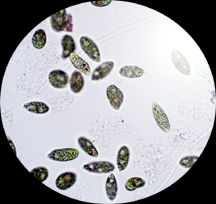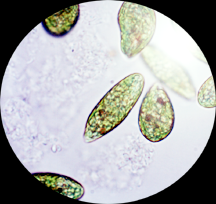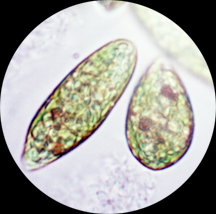| 
Scanning power (40X)
Use scanning power to locate and center the objects.
You may not be able to distinguish much detail at this point.
It's okay to use an air bubble (black circle
on the left) for focusing. After you have focused the slide
with the scanning objective, switch to the low power lens and
focus using the fine adjustment. Then move on to the oil-immersion
lens to see the bacteria. |

Low power (100X)
Use low power to center and focus the image. After
you have focused the image with low power, switch to the high-dry
lens and focus using the fine adjustment.
|

High-dry objective (450X)
Focus using the fine adjustment. The cells are
more defined but intracellular detail cannot be seen. Move on
to the oil-immersion lens to see more detail. |

Oil-immersion objective (1000X)
Place a drop of oil on the slide; the lens sits
in the oil. Focus using the fine adjustment. Now you can see the
euglenoid's chloroplasts and red pigment that migrate to the surface
when it's warm. |